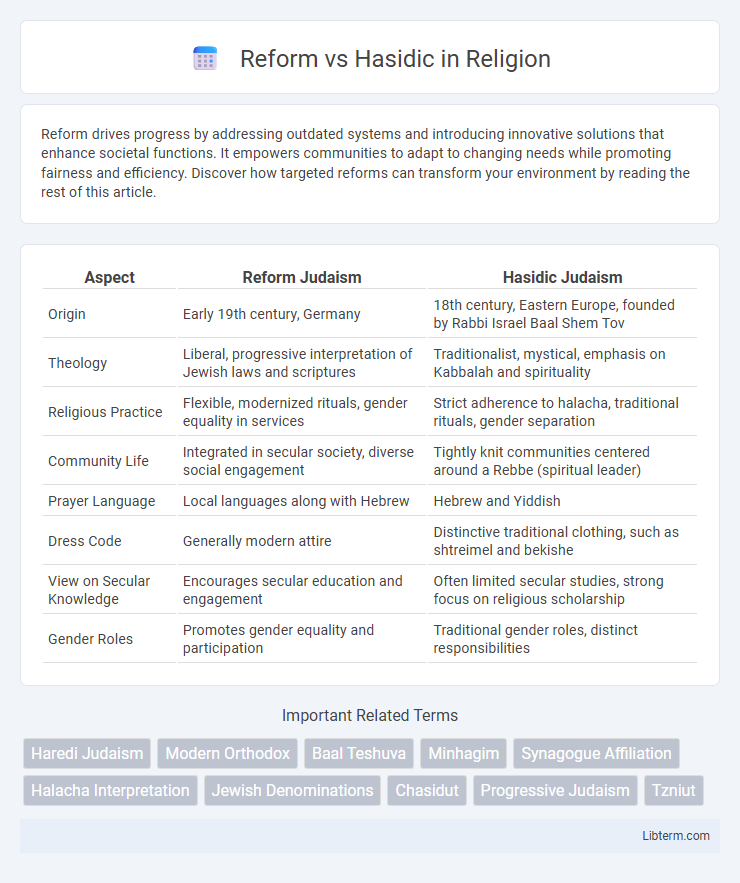Reform drives progress by addressing outdated systems and introducing innovative solutions that enhance societal functions. It empowers communities to adapt to changing needs while promoting fairness and efficiency. Discover how targeted reforms can transform your environment by reading the rest of this article.
Table of Comparison
| Aspect | Reform Judaism | Hasidic Judaism |
|---|---|---|
| Origin | Early 19th century, Germany | 18th century, Eastern Europe, founded by Rabbi Israel Baal Shem Tov |
| Theology | Liberal, progressive interpretation of Jewish laws and scriptures | Traditionalist, mystical, emphasis on Kabbalah and spirituality |
| Religious Practice | Flexible, modernized rituals, gender equality in services | Strict adherence to halacha, traditional rituals, gender separation |
| Community Life | Integrated in secular society, diverse social engagement | Tightly knit communities centered around a Rebbe (spiritual leader) |
| Prayer Language | Local languages along with Hebrew | Hebrew and Yiddish |
| Dress Code | Generally modern attire | Distinctive traditional clothing, such as shtreimel and bekishe |
| View on Secular Knowledge | Encourages secular education and engagement | Often limited secular studies, strong focus on religious scholarship |
| Gender Roles | Promotes gender equality and participation | Traditional gender roles, distinct responsibilities |
Origins of Reform and Hasidic Judaism
Reform Judaism originated in early 19th-century Germany as a response to Enlightenment values, emphasizing modernity, rationalism, and individual autonomy in religious practice. Hasidic Judaism emerged in the 18th century in Eastern Europe, founded by Rabbi Israel Baal Shem Tov, focusing on mysticism, spiritual enthusiasm, and community cohesion through charismatic leadership. These distinct origins reflect Reform's adaptation to contemporary society versus Hasidism's revival of traditional, mystical Jewish spirituality.
Core Beliefs: Reform vs Hasidic
Reform Judaism emphasizes individual autonomy, modern interpretation of Jewish laws, and gender equality, often adapting rituals to contemporary values while considering ethical principles paramount. Hasidic Judaism centers on mysticism, strict adherence to halacha (Jewish law), and the guidance of a Rebbe as a spiritual leader, prioritizing community cohesion and traditional practices. Both movements share foundational Jewish beliefs but diverge significantly in religious observance and cultural expression.
Worship Practices Compared
Reform Judaism emphasizes individual autonomy in worship, incorporating vernacular language, mixed-gender seating, and modern musical instruments to create an inclusive, dynamic service. Hasidic worship practices strictly adhere to traditional rituals, including prayers led in Hebrew, gender-segregated seating, and the use of melodies rooted in centuries-old spiritual customs. These divergent approaches reflect Reform's adaptation to contemporary contexts and Hasidic Judaism's focus on mystical devotion and communal continuity.
Attitudes Toward Jewish Law
Reform Judaism adopts a progressive attitude toward Jewish law, viewing it as a set of guidelines open to interpretation and adaptation to contemporary life, emphasizing individual autonomy and ethical principles. In contrast, Hasidic Judaism strictly adheres to halacha (Jewish law) as divinely mandated, with a focus on tradition, ritual observance, and spiritual devotion under the guidance of a Rebbe. This fundamental difference defines Reform's flexible approach versus Hasidic commitment to maintaining established religious norms.
Gender Roles and Inclusion
Reform Judaism actively promotes gender equality by ordaining female rabbis and embracing LGBTQ+ inclusion, reflecting progressive interpretations of Jewish law. Hasidic communities maintain traditional gender roles, emphasizing distinct responsibilities for men and women rooted in religious texts and customs. The contrast highlights the broader spectrum within Judaism regarding modernity, identity, and communal participation.
Community Structure and Leadership
Reform Jewish communities typically emphasize democratic leadership with elected boards and rabbis who encourage individual autonomy, resulting in a more flexible and inclusive community structure. Hasidic communities follow a hierarchical model centered around a Rebbe, whose spiritual authority governs religious life and communal decisions, fostering strong cohesion and adherence to tradition. This centralized leadership in Hasidic groups contrasts with the decentralized decision-making seen in Reform congregations.
Approaches to Modernity
Reform Judaism embraces modernity by adapting traditional practices to contemporary values, emphasizing individual autonomy and gender equality, while Hasidic Judaism maintains strict adherence to halachic law and resists secular influences to preserve spiritual purity. Reform congregations often incorporate secular education and progressive social ideals, contrasting with Hasidic communities that prioritize insular lifestyles and mystical devotion. These divergent approaches highlight Reform Judaism's flexibility in modern life versus the Hasidic commitment to preserving traditional religious identity amidst modern challenges.
Education and Family Life
Reform Judaism emphasizes secular education alongside religious studies, encouraging critical thinking and gender equality in family roles, fostering open dialogue within households. Hasidic communities prioritize intensive Torah study from a young age, with large families and traditional gender roles reinforcing close-knit, faith-centered family life. Educational environments in Hasidic settings are predominantly religious, while Reform families support diverse academic pursuits paired with progressive values.
Dress and Symbols of Identity
Reform Judaism adopts modern, often secular clothing styles, emphasizing individual expression and minimal use of traditional symbols, while Hasidic Jews strictly adhere to distinctive dress codes such as black coats, fur hats (shtreimels), and white shirts, which symbolize community identity and religious devotion. Hasidic men commonly wear payot (side curls) and tallit katan (fringed garments) as visible markers of faith, whereas Reform Jews typically do not maintain these traditional symbols in daily attire. The contrasting dress codes and symbols serve as powerful indicators of theological and cultural differences between the progressive Reform movement and the conservative Hasidic sect.
Relations With Broader Society
Reform Judaism promotes integration with broader society by encouraging secular education and social engagement, aligning religious practices with modern values and emphasizing inclusivity. Hasidic communities often maintain strict boundaries, prioritizing religious traditions and insular lifestyles that limit interaction with secular culture to preserve spiritual purity. The differing approaches impact social relations, with Reform Jews actively participating in civic life while Hasidic groups focus on sustaining distinct cultural and religious identities.
Reform Infographic

 libterm.com
libterm.com